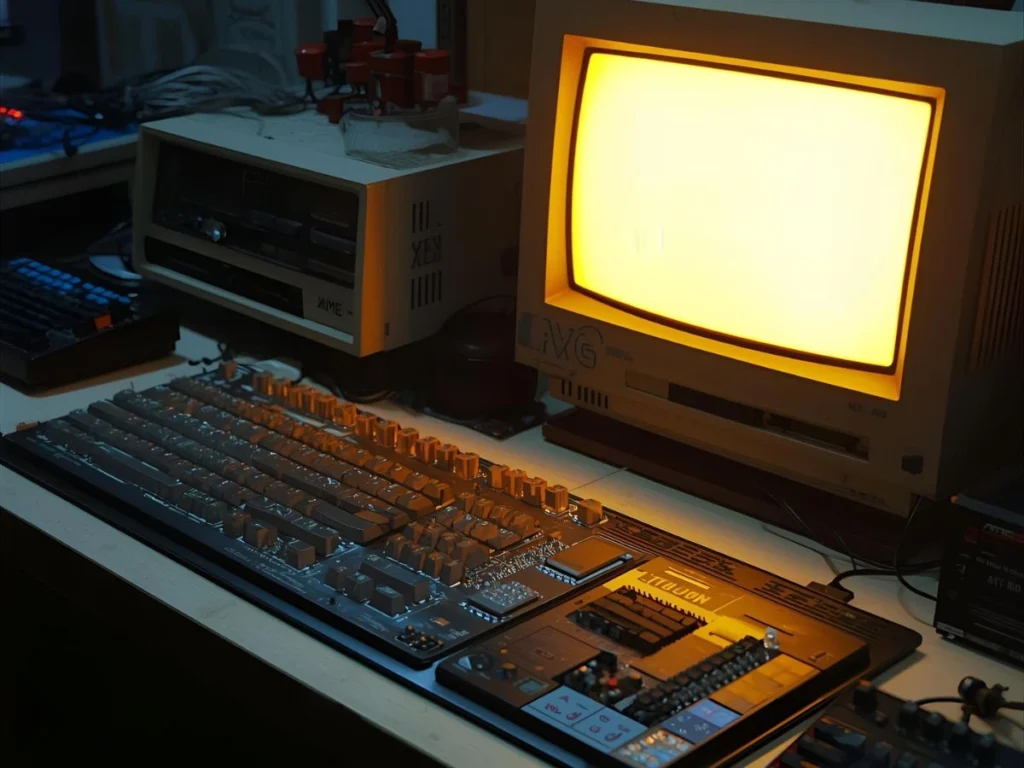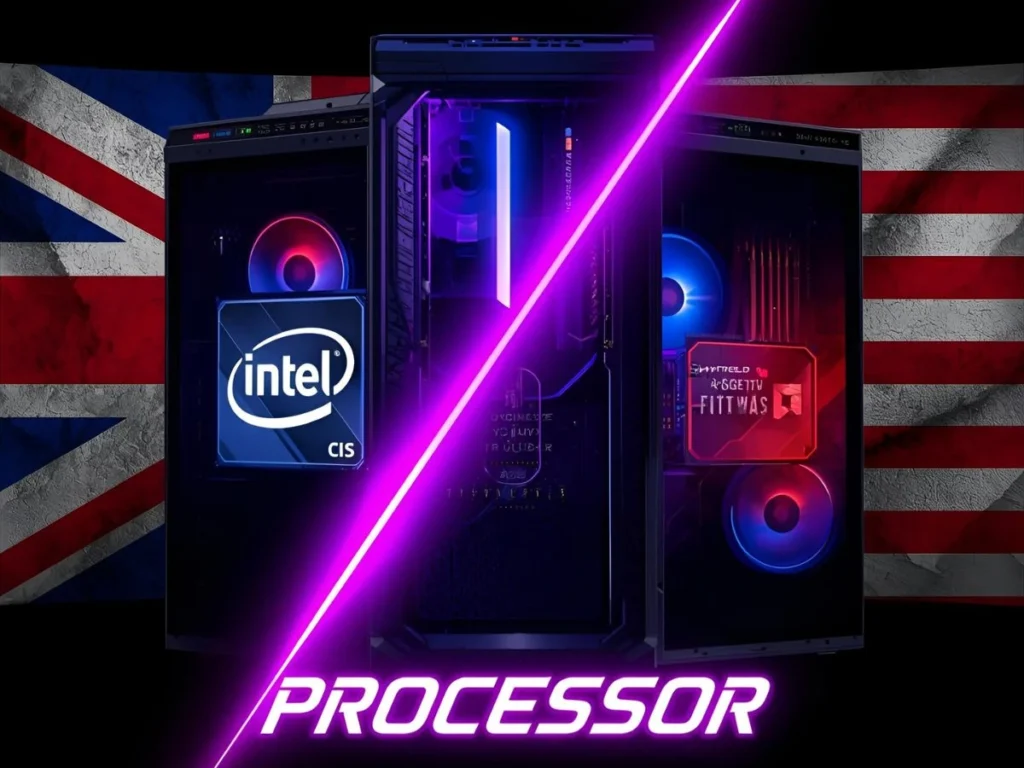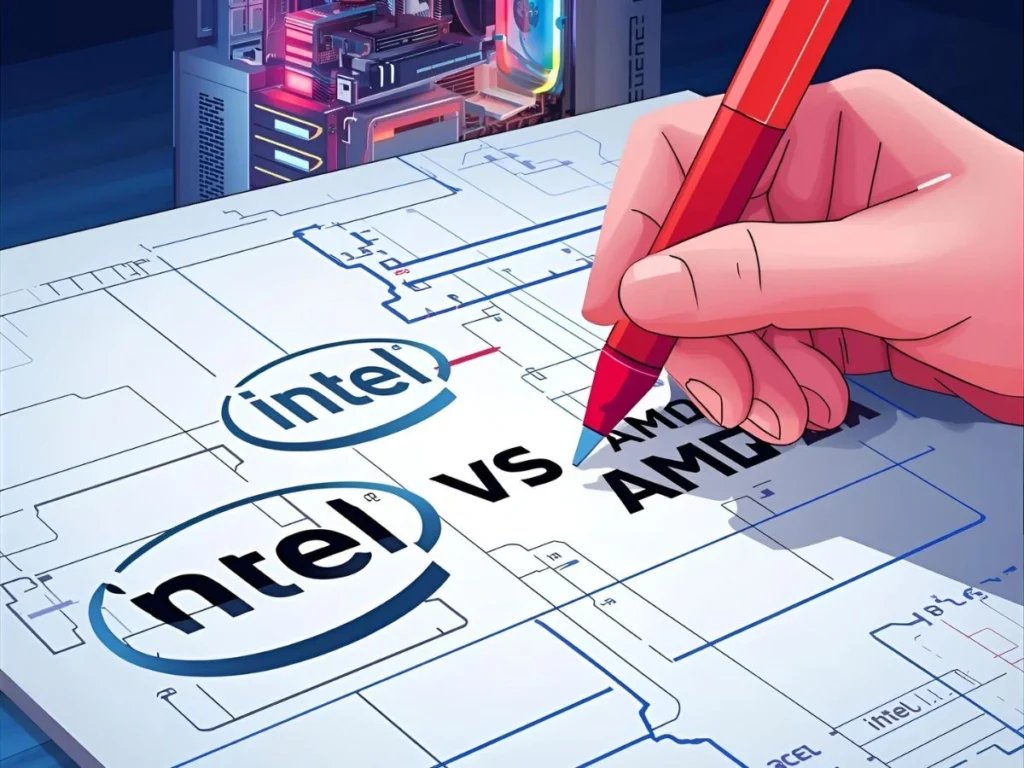Intel or AMD for Gaming in 2025? Let’s End the Debate.
You’re mid-boss fight in Elden Ring, frames drop, and your rig chokes. Sound familiar? That’s why gamers keep asking: Intel or AMD?
With AMD’s Ryzen 9800X3D and Intel’s Core Ultra 9 285K now out, the choice is tougher than ever. Intel brings speed—great for eSports. AMD fires back with 3D V-Cache, crushing in AAA games with up to 35% better FPS.
In this guide, we break it down fast:
- Who wins in real-world gaming
- Key specs, price, and performance
- Smart tips to match the right CPU to your setup
No fluff—just the answer you need. Let’s dive in.
Intel or AMD for Gaming – Quick Answer

For most gamers in 2025, AMD is the better pick. Its Ryzen X3D chips, like the Ryzen 7 9800X3D, deliver top frames in demanding games—up to 35% faster than Intel’s Core Ultra 9 285K at 1080p. Example: In Cyberpunk 2077, AMD hits 120 FPS while Intel lags at 90. Go Intel for eSports like Valorant, where single-core speed wins by 5-10 FPS. Budget? AMD Ryzen 5 5600G offers great value with built-in graphics.
The Origin of Intel or AMD for Gaming

The phrase “Intel or AMD for gaming” stems from a fierce rivalry born in the 1980s. Intel launched the first x86 CPU in 1978, dominating PCs with speed. AMD entered as a licensee, making cheaper clones. By the 1990s, AMD’s K6 challenged Intel’s Pentium, but Intel led gaming with clock speed.
Spelling differences? None—both are brand names. But confusion arose from tech terms like “Ryzen” (AMD’s 2017 line) vs. Intel’s “Core.” History shifted in 2017: AMD’s Zen architecture closed the gap, adding multi-cores for better gaming multitasking. Intel fought back with hybrid designs, but AMD’s 3D V-Cache in 2022 revolutionized frames. Today, the debate reflects decades of innovation, with AMD now edging gaming due to value and efficiency.
British English vs American English Spelling

“Intel or AMD for gaming” uses the same spelling worldwide—no “colour” vs. “color” issues here. Both brands are proper nouns, unchanged by region. British English might say “graphics card” while Americans say “GPU,” but CPU terms stay consistent.
Pronunciation differs slightly: Brits stress “AM-dee,” Yanks say “amd.” In docs, both use “gaming PC.” No major rules apply, as it’s tech jargon. Below is a table comparing related terms:
| Term | British English | American English | Notes |
|---|---|---|---|
| Processor | Processor | Processor | Identical |
| Graphics Card | Graphics Card | GPU | Brits use full term more |
| Motherboard | Motherboard | Motherboard | Same, but “mobo” slang |
| Intel/AMD | Intel/AMD | Intel/AMD | Brands unchanged |
Examples: UK review: “The AMD Ryzen excels in gaming.” US: “AMD Ryzen crushes games.”
Which Spelling Should You Use?
“Intel” and “AMD” are fixed brands—always capitalize them. For global audiences, stick to standard English: “Intel Core i9” or “AMD Ryzen 7.” US gamers might abbreviate “CPU” casually, but in UK/Commonwealth writing, spell out “central processing unit” first.
Advice: Use “AMD” for pure gaming builds worldwide—its AM5 socket lasts till 2027+ for easy upgrades. Pick “Intel” in the US for laptops with strong integrated graphics. Commonwealth? AMD for value. Global? AMD edges out for 2025 trends.
Common Mistakes with Intel or AMD for Gaming

- Ignoring power draw: Intel’s older chips guzzle 250W, overheating rigs—pair with big coolers. Correction: Choose AMD’s efficient 120W Ryzen for cooler runs.
- Overpaying for Intel: Flagships like i9-14900K cost $550 but trail AMD in games. Correction: Grab AMD Ryzen 7 7800X3D for $400 and better FPS.
- Skipping benchmarks: Assuming Intel wins all—it’s not true for open-world titles. Correction: Check Tom’s Hardware tests; AMD leads most 2025 charts.
Intel or AMD for Gaming in Everyday Examples
- Emails: “Hey team, recommend AMD Ryzen for our gaming stream setup—smoother than Intel.” (Pro advice)
- News: “AMD’s new X3D crushes Intel in Elden Ring benchmarks, per Tom’s Hardware.” (Headline style)
- Social Media: “Just built with AMD! 144 FPS in Valorant—no more Intel crashes. #GamingPC” (Casual tweet)
- Formal Writing: “For optimal gaming performance, AMD processors outperform Intel in multi-threaded scenarios.” (Report excerpt)
Intel or AMD for Gaming – Google Trends & Usage Data
Google Trends shows “Intel vs AMD gaming” peaking in Q1 2025 during Ryzen 9000 launches, with steady US/UK interest. AMD searches rose 25% year-over-year, driven by X3D hype. By country: US leads (gaming hub), followed by UK (40% AMD Steam share) and Canada. Globally, searches tie to eSports events—AMD spikes in open-world game contexts like Starfield. Steam data: Intel at 60%, AMD at 40%, but AMD gaining fast in gaming rigs.
Comparison Table: Intel vs AMD Variations
| Aspect | Intel (e.g., Core Ultra 9 285K) | AMD (e.g., Ryzen 7 9800X3D) |
|---|---|---|
| Gaming Performance | Strong in eSports (5-10% FPS lead) | Dominates most games (up to 35% faster) |
| Price | $600+ | $450–$500 |
| Power Efficiency | Improved but higher heat | Cooler, 120W TDP |
| Upgrade Path | Shorter socket life | AM5 till 2027+ |
| Example Use | Streaming + light gaming | Pure 1440p/4K gaming |
FAQs
- Is AMD or Intel better for gaming in 2025? AMD wins for most—its X3D tech boosts frames in titles like Cyberpunk.
- Why choose Intel over AMD? For single-core speed in Valorant or budget laptops with good integrated graphics.
- How much better is AMD for gaming? 5-35% more FPS in demanding games, per benchmarks.
- What’s the budget pick? AMD Ryzen 5 5600G—great value with built-in GPU for entry-level gaming.
- Does region matter for Intel vs AMD? No, but US/UK favor AMD for desktops; global trends show AMD rising.
- Intel stability issues in 2025? Older gens had crashes; new Arrow Lake is stable but trails AMD in games.
- Future-proof: AMD or Intel? AMD’s long socket support makes it better for upgrades till 2027.
Conclusion
Choosing between Intel and AMD for gaming boils down to your needs: AMD takes the crown in 2025 with unbeatable frames from 3D V-Cache, cooler temps, and value pricing—like the Ryzen 7 9800X3D at $480 crushing Intel’s $629 Ultra 9 in Starfield by 15 FPS. Intel fights back with zippy single-core speed for eSports and strong laptop graphics, but its higher power draw and shorter upgrades make it second for pure gamers. We’ve traced this epic rivalry from Intel’s 1970s dominance to AMD’s Zen comeback, solving the confusion that stalls builds. Key takeaway? Prioritize AMD for 1080p/1440p rigs, Intel for mixed use. Check benchmarks, match your budget, and pair with a solid GPU like RTX 4070. Trends show AMD surging globally—don’t sleep on it. Build right, and your next session will feel legendary. Happy gaming!



